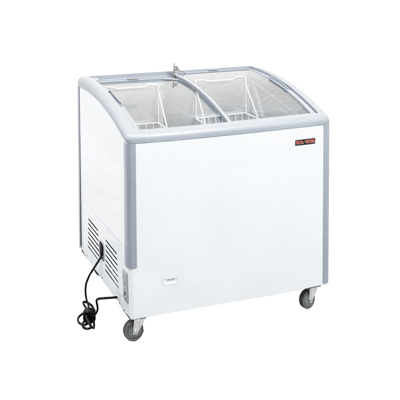3 Types of Ice Machine Condensers: An Excellent Buyer’s Guide

Explore our buyer’s guide on ice machine condenser types and learn about air-cooled, water-cooled, and remote condensers!
Table of Contents
When selecting a commercial ice maker, understanding the different types of ice machine condensers is essential for ensuring optimal performance and efficiency.
Specification Differences: Air-cooled, Water-cooled, and Remote Condenser Ice Machines
Ice machines come equipped with a critical component – the condenser. The condenser is responsible for removing excess heat from the machine. There are three main types of ice machine condensers, and the right choice will depend on the needs of your specific venue. If you’re looking for a quick overview of everything you need to consider when choosing a commercial ice maker, check out our comprehensive guide, “Commercial Ice Maker: Your No. 1 Guide to Choosing the Perfect One”.
Air-Cooled Condensers
Air-cooled commercial ice makers are the most common type of ice machine condenser. These machines have fans that draw fresh air across the condenser to cool the equipment. When the entire condensing unit is contained within the ice machine itself, these are the simplest to install and maintain, requiring only a standard electrical connection. However, you’ll need to ensure the machine has adequate clearance around it to allow for proper airflow. If the ambient air temperature in the room regularly exceeds 80°F, an air-cooled self-contained machine may not be the best choice, as the high temps can reduce ice production and cause the machine to fail prematurely. In those cases, a remote condenser model may be preferable.
Air-cooled condensers are the most affordable and widely used option for ice machine condensers. If you’re looking to minimize upfront costs and installation complexity, an air-cooled self-contained ice machine is likely the simplest choice. As long as you can accommodate the necessary clearance around the unit, this is a practical solution for most applications. For the vast majority of restaurants and small to medium-sized businesses, an air-cooled ice machine condenser is the recommended choice due to its efficiency, cost-effectiveness, and ease of maintenance.
Water-Cooled Condensers
Another option is a water-cooled condenser. Like air-cooled self-contained models, the condenser is enclosed within the ice maker. But instead of using air, these machines pump cool water across the condenser coils to remove heat. This method requires a constant source of cool water beyond just the machine’s potable water supply, making it impractical for most establishments. Water-cooled machines are most viable for facilities that already have water-circulating chiller systems, as they can be very efficient and produce high ice output.
However, it’s important to note that water-cooled ice machine condensers are now considered largely obsolete in the foodservice industry. Their high water consumption and environmental impact have led to their decline in popularity. Many regions have even implemented regulations restricting their use. As a result, we generally do not recommend water-cooled condensers for new ice machine installations.
Remote Condensers
The third type is the remote condenser, which can be air or water-cooled. Rather than being integrated into the ice machine, the condenser is housed in a separate location, usually on the roof. Refrigerant is piped between the ice maker and the remote condenser. Remote condensers offer several advantages – they move the heat and noise-generating components outside the building, which can be important in customer-facing environments like hotels. However, remote condenser models come at a higher equipment and installation cost compared to self-contained units.
While remote-cooled condensers offer the advantage of moving the heat-generating components outside the main work or customer areas, they are typically only recommended for very large operations. Hotels, large restaurants, or institutional kitchens with extremely high ice production needs might benefit from a remote ice machine condenser. For most standard restaurants and small to medium-sized businesses, the added complexity and cost of a remote condenser system usually outweigh the benefits.

Choosing the Right Ice Machine Condenser
The right ice machine condenser type will depend on factors like ambient temperature, available space, noise considerations, and budget. For the vast majority of foodservice operations, an air-cooled ice machine condenser is the most practical and efficient choice. They offer a good balance of performance, cost-effectiveness, and ease of maintenance.
When selecting an ice machine condenser, consider the following:
- Ice production needs: Ensure the ice machine condenser can support your required daily ice output.
- Available space: Air-cooled condensers require adequate ventilation, so factor in clearance requirements.
- Ambient temperature: If your kitchen regularly exceeds 80°F, you may need to explore alternative cooling options or improve overall ventilation.
- Noise considerations: While air-cooled condensers can produce some noise, modern designs have significantly reduced this issue for most applications.
- Energy efficiency: Look for ENERGY STAR certified models to minimize operating costs.
Consulting with our experienced technicians at Babak Food Equipment can help determine which ice machine condenser option best suits your specific needs. We can provide expert guidance on selecting the most appropriate and efficient ice machine condenser for your unique situation, ensuring you get the best performance and value from your ice production equipment. For personalized advice or to see our selection in person, we invite you to drop by and visit us at our showroom.






















































